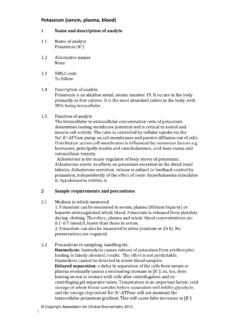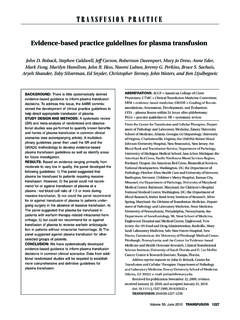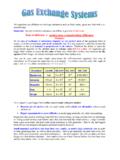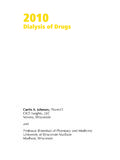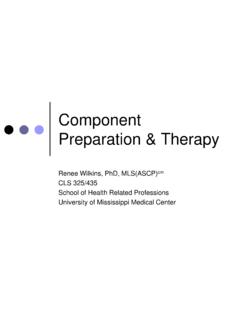Transcription of Determination of Surface Temperature in ICP RF …
1 DOI: Research. 2017; 20(5): 1432-1443 2017 Determination of Surface Temperature in ICP RF plasma Treatments of Organic MaterialsCarlos Eduardo Fariasa, Euclides Alexandre Bernardellia, Paulo Cesar Borgesa, M rcio Mafraa*Received: March 01, 2017; Revised: May 30, 2017; Accepted: July 12, 2017 The reactions that can occur on organic materials treated in plasma enviorement are strongly affected by Surface Temperature , thus the sharp Determination of this variable is extremely important to process control. In situ Temperature measurements are often employed; however, the measured point is generally under the treated Surface . If in metallic materials the high thermal conductivity minimizes this problem, in non-metallic materials processing it becomes important, because its thermal resistivity besides a high sensibility to small Temperature variations.
2 The present work uses a simulation tool to extract thermal data on Ar+O2 RF plasma processing of Stearic Acid. Experimental data were obtained by thermocouples placed inside the samples. The extrapolation of Surface Temperature was performed by numerical simulation with Autodesk CFD software Results show that the Temperature of the Surface reaches values higher than the ones measured inside the sample holder. This difference of Temperature is in good agreement with the visual observation of the phase transformations in the treated material, showing a simple and valuable tool to better control of plasma : Ultimate Surface Temperature , RF plasma treatment, Temperature simulation.* e-mail: IntroductionIt is already common knowledge, by thermodynamic laws and Arrhenius equation, that the material's Temperature influences its reactivity with the environment, either in kinetic form (reaction rate), in the form of activation energy (heat required to allow the beginning of a reaction)1, Surface Temperature for processes like etch rate2, deposition rate3-5, or polymerization4,6 of the materials exposed to plasmas.
3 However, there are cases in which is necessary to avoid the occurrence of specific reactions by controlling the reached Temperature on materials Surface , such as in food sterilization processing that degrades the flavor in higher temperatures7, controlled solidification8, precipitation of unwanted second phases in metal alloys, grain growing, and phase change in ceramics9. Therefore, many works were conducted with techniques that would allow the measurement of this variable in Surface treatments, especially in plasma cleaning and degradation plasma processes, where specific reactions of organic compounds depends on the temperature10,11, the correct analysis of this variable is very important. Previous works found that when stearic acid heats due to reactions with plasma , it melts and this leads to many undesirable effects, such as the formation of resistant compounds and boiling.
4 It has already been evidenced that in relatively high temperatures (313 K)12,13, even when the material begins in the solid state, functionalization reactions becomes more important than degradation, leading to polymerization processes. On the other hand, treatments at lower temperatures (273 K) lead to high mass loss, where the possible by-products of functionalization are removed in degradation most studies of plasma degradation, the Temperature measurement was obtained by a thermocouple, which is placed into the sample holder or into the sample itself. However, the exposed Surface reacts with the plasma active species and could reach higher temperatures than those measured. Also, simply placing the tip of the thermocouple exactly on the Surface is not an efficient method because plasma species could interact with the metallic tip, heating it more than the examined many different Temperature measurement techniques like thermocouple, resistance thermometer, thermal-paper (also found in15 and16), autoclave tape and a fiber-optic sensor.
5 Among all these techiniques, he found that fiber-optic system was a reliable method since it did not suffer from the heating effect of charged particles from the discharge. However, some plasma reactors do not allow the easy placement of this kind of fiber inside the o17 and Leal18 have extrapolated the Surface Temperature of a steel AISI M35, analyzing its microstructure and hardness along the thickness of this metal exposed to plasma . They concluded that on a microlayer of Surface material, the Temperature could be more than 100 K higher than the and Amiel19,20 have used infrared cameras to analyze the Surface Temperature of materials treated under special plasma and laser conditions. Salter19 observed that the desorption of organic molecules over a Si subtract are Temperature -dependent, which is related to its own vapor pressure.
6 Amiel20 observed that the measured Surface aUniversidade Tecnol gica Federal do Paran - UTFPR, Curitiba, PR, Brazil1433 Determination of Surface Temperature in ICP RF plasma Treatments of Organic Materialstemperature by IR camera was slightly higher than the one measured above the subtract with a thermocouple. However, not every system allows the visualization of a sample Surface Temperature and still needs other approaches to reach a correct and Osch21 used experimental methods and numerical analysis to extrapolate values to extreme conditions of samples exposed to ion implantation and lasers, working with very high temperatures and shorter times. In those cases, errors of tens of degrees are easily acceptable. However, when working with cold plasma systems, this kind of error could mean very different material most systems, the use of thermocouples to measure Temperature inside a subtract is acceptable due to a good heat conductivity of the subtract and the simplicity of setup.
7 On the other hand, when the heat conductivity of treated materials is low, as in polymer and other organic molecules processing, simply using a thermocouple inside a substact holder is not enough because these materials are very sensitive to small Temperature variations on its works on RF discharge by Farias10, DC and after-glow by Bernardelli12,22 and Mafra13, used thermocouples inside the crucible and inside the sample, respectively. However, since reactions between sample and plasma generated species happen on the Surface and the sample has a thickness of about a few millimeters, at least at the beginning of the treatment, there should be a delay on Temperature measurements. Therefore, the present work present a way to achieve a most accurate value of Surface Temperature , by combining the thermocouple measurements into the sample and numeric simulation of the Temperature at plasma -sample Materials and Experimental setupThe experimental setup is depicted in Figure 1.
8 Figure 1a shows the plasma reactor, which consists of a borosilicate tube with 34 mm inner diameter, 650 mm length and 2 mm thickness. The plasma is generated by a copper coil with 9 turns, connected to a radio frequency power source Tokyo Hi-Power, RF-300 model (and a matching box model MB-300), with a frequency of MHz, which was used with the fixed power of 50 W (400 V peak-to-peak). The atmosphere is composed by a gas mixture of Ar-10vol% O2 flowing at 750 sccm at pressure of Temperature control system[1] (TCS) consisting of water recirculation (pumped at 95 L/h), covering 110 mm of the discharge tube length, was used. The sample holder is made of poly-tetrafluoroethylene, and its design and dimensions are shown in Figure 1b.
9 A 4 mm deep fitting groove is provided to place the sample. The curved face of the sample holder is shaped to allow good coupling between the sample holder and the glass tube. The work material was 95% pure Stearic Acid ( ), because it is a standard molecule to plasma degradation studies. It was placed on the sample holder in a molten state, until a small amount was above the Surface . When solidified, the excess of was scraped with the aid of a metallic blade, to produce a flat Surface . Due experimnental setup, it is not possible to move or visualize the sample during treatment as in many other plasma reactors. However, this material has a melting point at 341 K that will be used as a Temperature thermocouple (Type K) can be placed at two different positions, always at 7 mm above the base of the sample holder (in central line), and penetrating the sample holder approximately 12 mm, from the front or back sides.
10 Due to RF field of plasma source, there was some interference in the thermocouple measurements. These were observed as a constant increase in reading value while the RF source remained on. After several adjustments in the configuration, position and electrical insulation of the equipment, the increment was reduced to differences smaller than 2 K. After each experiment, when the RF source was turned off, the value of the difference in the Temperature reading was noted and used to correct the sample holder was placed in the central position of TCS in all experiments. The model used for the simulation corresponds to a section of 10 mm length of the front and back positions of the sample holder, with the glass, as shown in Figure experiment was repeated four times, and the error bars are calculated as a confidence interval of 95%.












